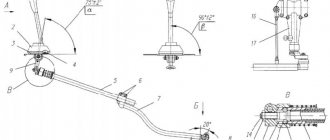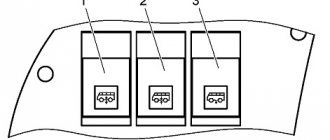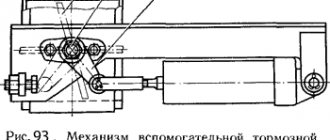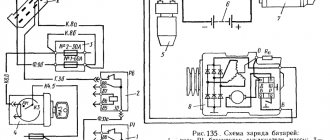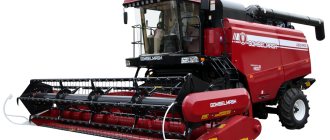The engine cooling system (Fig. 1) is liquid, closed type, with forced circulation of coolant
It consists of the following main elements; radiator, expansion tank, 7 water pump, fan, 2 thermostats and remote thermometer
When the engine is running, the circulation of coolant in the cooling system is created by a centrifugal pump.
The pump takes fluid from the lower radiator reservoir and forces it through the channels in the timing gear cover into the right and left water jackets of the cylinder block.
Here the liquid washes the outer surface of the cylinder liners, absorbing heat, heats up, then from the cylinder block enters the water jackets of the cylinder heads and, first of all, to the hottest places - the exhaust valves and injector cups.
From the cooling jacket of the cylinder heads, the liquid enters the drainage pipes, and from them through passages in the thermostats into the radiator, where it transfers heat to the air flow created by the fan. The liquid cooled in the radiator again flows to the water pump.
Water pump (Fig. 2). Blade, centrifugal type - to prevent liquid from entering the cavity with lubricant, install a cuff 8 made of oil- and petrol-resistant rubber, which is pressed with clips to the shaft, and by a spring to the textolite thrust ring 6.
The radiator is a tubular-tape (snake) with oval-section tubes, three-row, mounted on the frame through rubber cushions.
A plug with a steam-air valve is installed on the expansion tank. The outlet valve of the plug opens at an excess pressure of 0.5 kgf/cm2, which corresponds to water boiling at about 119˚ C.
The inlet valve of the plug opens when the pressure in the system drops to 0.13 kgf/cm2.
Thermostats
They serve to speed up the warm-up of a cold engine and protect it from hypothermia on the road.
When the temperature of the cooling system fluid drops to 70˚ C, thermostats automatically direct its entire flow directly to the water pump through the so-called small circulation circle, bypassing the radiator, and thereby create favorable conditions for its rapid heating.
The radiator shutter can be fixed in any intermediate position and is controlled from the driver's cab.
The six-bladed fan, gear-driven, rotates in the radiator casing.
Cooling System Maintenance
To ensure normal operation of the cooling system, it is necessary:
— fill the cooling system with a special all-season liquid antifreeze - A 40 (composition by volume: antifreeze-A - 56%, clean water - 44%) or antifreeze A65 (antifreeze-A - 65%, clean water - 35%).
- pour the liquid through a funnel with a mesh, using clean dishes;
— monitor the temperature of the coolant, which should be in the range of 75–98 ˚ C;
— regularly check the coolant level through the neck of the cap on the expansion tank and top up if necessary. Measure with a cold engine. The minimum coolant level should be 10 mm from the bottom of the expansion tank;
— in the summer, monitor the condition of the air channels of the radiator core and be sure to clean them if they are significantly clogged. Cleaning can be done with a jet of compressed air directed into the air channels of the radiator core from the casing side;
— lubricate the water pump bearings in a timely manner.
Body and cabin
The vehicle platform has the following overall dimensions:
- length – 6.2 m,
- height – 0.536 m,
- width – 2.48 m.
The body used on the MAZ-4370 is low-frame. This is precisely its main advantage: with the help of this design, it is possible to transport large loads of great height without obtaining various permits.
Thanks to the low-frame body, it is possible to load an impressive volume of various bulk materials above the sides, with a slide, thereby significantly increasing the mass of cargo transported at one time.
It is possible to install an awning or other equipment on the frame. In the last few years, modifications of the MAZ-4370 have been released, the platform of which is equipped with truck cranes, concrete mixers, manipulators and other similar special equipment.
In fact, the main purpose of this tractor is to transport goods over short distances (urban and intercity routes). But every day it is increasingly used to transport them abroad.
This may be due to the rather unique configuration of the cabin. It is very comfortable and spacious, unlike similar domestically produced cars.
MAZ-4370 can be equipped with the following cab:
- double (with sleeping bag),
- triple (without sleeping bag).
Read also: Do-it-yourself motor swamp vehicle drawings
The design of the double cabin includes a sleeping place, thanks to which you can feel quite comfortable on the road: if the driver is tired, he can simply park in the nearest suitable place and rest.
The sleeping area is folding and can be easily stowed into the rear wall of the cabin if necessary.
Another very important advantage of the MAZ cab is that it is equipped with an electronically controlled heater. This makes the room very comfortable during winter trips. Also, if desired, you can install additional heating equipment.
The cabin is not very modern, but nevertheless very comfortable. It is easy to climb into – it is located low on the frame. There are no protrusions or bumps on the cabin floor.
The doors on both sides have special handrails, with which you can get inside very easily and quickly. If you want to buy or sell a Case combine harvester, we will tell you the price level on the agricultural machinery market.
The MAZ-4370 is somewhat inferior to its foreign counterparts in terms of carrying capacity, but is superior in overall dimensions and cost. Its price may vary depending on the dealer and the region of purchase, but usually it does not exceed 1.5 million rubles.
Most drivers of this truck speak especially well of the chassis and cab. But the engine and other car systems also rarely cause serious complaints. MAZ is extremely easy to repair.
Its design does not contain any components that could not be repaired by any driver on his own if he had an overpass and the necessary tools.
Checking the tightness of the system
A significant portion of cooling system malfunctions are due to coolant leaks.
The most likely places for leakage are water pump seals, connections between hoses and pipes, radiator pipes and tanks, and drain valves.
The tightness of the cooling system should be checked daily.
If the water pump impeller seal is faulty, fluid will flow out through the drain hole on the housing, which will protect the pump shaft bearings from destruction.
It is not allowed to eliminate fluid leakage from the pump by blocking the drain hole. A pump with a faulty seal must be repaired.
Leakage at the hose interfaces is eliminated by tightening the clamps, and if the hoses are damaged, by replacing them.
Adjusting the tension of the water pump drive belt. A normally tensioned belt, when pressed with the thumb on the middle of the belt with a force of 3 kgf, should bend by 10 - 15 mm.
Spare parts for Ural, Kraz, MAZ, Kamaz trucks. Engine parts YaMZ-236, YaMZ-238
__________________________________________________________________________
__________________________________________________________________________
Engine cooling system YaMZ-236 and its components
___________________________________________________________________________
The cooling system of the YaMZ-236 engine of the MAZ-5551, MAZ-5335, 5336, 5337 and Ural-4320, 43206, Ural-5557 vehicles is liquid, circulating.
The cooling system includes a water pump, fan, thermostats, remote thermometer and a radiator mounted on the machine frame. During operation of the YaMZ-236 engine of the Ural-4320, 43206, Ural-5557 and MAZ-5551, MAZ-5335, 5336, 5337 vehicles, the circulation of coolant in the cooling system is created by a centrifugal pump. From the discharge pipe of the pump, through the channels in the cover of the distribution gears, liquid under pressure enters the water jacket of the left row of cylinders and the right row of the cylinder block, then into the cylinder heads and is collected in the drainage pipelines. Liquid is supplied to the water jackets of the cylinder heads through guide channels, primarily to the most heated surfaces - exhaust pipes and injector cups. From the drainage pipelines, the heated liquid is supplied through thermostats to the radiator, where it gives off heat to the air flow created by the fan, after which it again goes to the YaMZ-236 water pump. When coolant temperature drops, thermostats automatically direct all coolant flow directly to the water pump, bypassing the radiator. Thus, through thermostats, the optimal thermal operating conditions of the engine are ensured. The YaMZ-236 water pump is of centrifugal type, installed in the front part of the engine of MAZ-5551, MAZ-5335, 5336, 5337 and Ural-4320, 43206, Ural-5557 cars and is driven by a V-belt from a pulley mounted on the front end of the crankshaft . An impeller, pressed onto a roller, rotates in a cast iron housing. The pump shaft is mounted on two ball bearings with a one-way seal. When assembling the pump, the bearing cavity is filled with Litol-24 lubricant for the entire service life of the pump without additional lubrication. The pump cavity is sealed along the end surfaces. To monitor the tightness of the mechanical seal, there is a drainage hole in the pump housing. The water pumps installed on YaMZ-236 engines have significant design differences and are not interchangeable with each other: - The water pump of YaMZ-236N,B engines (Fig. 21) is marked on the housing 236-1307010-A3. — The water pump of the YaMZ-236NE,NE2,BE,BE2 engines is marked on the housing 236-1307010-B1. Fig.21. Water pump of the YaMZ-236 engine 1 – housing; 2 – nipple; 3 – roller; 4 – ball bearings; 5 – retaining ring; 6 – bushing; 7 – pulley; 8,10 – nuts; 9 – lock washer; 11 – adjusting gasket; 12 – hairpin; 13 – water dispenser; 14 – body bushing; 15 – retaining ring; 16 – thrust ring; 17 – sealing ring; 18 – impeller fastening nut; 19 – oil seal cuff; 20 – spring; 21 – impeller; 22 – housing cover. Maintenance of the cooling system of YaMZ-236 engines The efficiency, reliability, service life and other indicators largely depend on the proper operation of the YaMZ-236 engine cooling system of the Ural-4320, 43206, Ural-5557 and MAZ-5551, MAZ-5335, 5336, 5337 vehicles. engine. To ensure normal engine operation, fulfill the following requirements: Fill the YaMZ-236 engine cooling system with recommended special low-freezing liquids or, in exceptional cases, for a short time with clean soft water. Pour coolant through a funnel with a mesh using clean containers. Monitor the coolant temperature, maintaining it within 75 – 90ºС. To avoid the occurrence of deformations of the heads and jacket of the cylinder block, add coolant to the cooling system of a warm engine gradually and always during operation. If the cooling system of the YaMZ-236 engine of the MAZ-5551, MAZ-5335, 5336, 5337 and Ural-4320, 43206, Ural-5557 vehicles is filled with water, then regularly flush the cooling system with clean water using a special flushing gun, and if it is not available - with a strong stream of clean water, preferably pulsating. Systematically remove scale from the cooling system. When using antifreeze as a coolant, it is necessary to periodically monitor its color. If antifreeze acquires a red-brown color, this indicates its aggressiveness towards the structural materials of engine parts.
In this case, the antifreeze must be replaced, having first flushed the cooling system. Monitor the serviceability of the mechanical seal of the water pump impeller, keeping in mind that coolant leaking into the water pump bearings damages them. A faulty mechanical seal is indicated by water leaking from the drainage hole on the water pump housing, which must not be plugged. A pump with a faulty seal must be repaired. In case of temperature violation, check the serviceability of thermostats and their gaskets.
The starting temperature of the main thermostat valve should be 80±2ºС (indicated on the thermostat body). The valve must open completely, moving at least 8 mm from its seat. Replace the faulty thermostat with a new one. Water pump of YaMZ-236 engines Features of disassembling and assembling the water pump installed on YaMZ-236 engines of Ural-4320, 43206, Ural-5557 and MAZ-5551, MAZ-5335, 5336, 5337. Fig. 22 . Water pump of the YaMZ-236 engine 1–body; 2–impeller; 3-face seal; 4–bushing; 5– shaft; 6–water release; 7–plug; 8–supply pipe; 9–circlip; 10–pulley; 11, 12 – sealing rings; 13–bearings; 14, 15 – fastening nuts and spring washers. Disassembling the YaMZ-236 water pump (pump) Loosen the fastening of the YaMZ-236 water pump (pump) drive belt tensioner, remove the belt from the water pump pulley. Drain the engine and radiator coolant. Remove the inlet pipe from the water pump. After unscrewing the fastener, remove the water pump from the engine, being careful not to damage the gasket. Unscrew nuts 14 (Fig. 22) of pipe 8. Lightly tapping the protruding parts of pipe 8 in the direction of arrows B, remove the said pipe from pump housing 1. Secure impeller 2 (or pulley 10) from rotation with shaft 5. Unscrew plug 7 from the threaded hole of impeller 2. Screw nut 17 of the puller into the threaded hole (M22x1.5) of impeller 2 and, screwing in bolt 18, press impeller 2 from shaft 5. Bend the “whiskers” D of the mechanical seal housing 19 and remove the cuff 22 with the spring and frames assembled. Using a puller, compress pulley 10. Remove retaining ring 9 from the groove of pump housing 1. Press shaft 5 with water ejector 6 and bearings 13 out of housing 1. If the brass housing 23 of the mechanical seal is not damaged, it can not be removed from housing 1 at this time disassembly of the pump can be considered complete. Assembling the YaMZ-236 pump Wash all parts of the water pump of the YaMZ-236 engine of MAZ-5551, MAZ-5335, 5336, 5337 and Ural-4320, 43206, Ural-5557 cars and dry with compressed air. Press bearings 13 and water dispenser 6 onto shaft 5 (Fig. 22). In this case, it is necessary to: − pre-lubricate shaft 5 with diesel oil; − install bearings 13 so that the sealing washers are on the outside; − apply pressing force to the inner ring of the bearing. Fig.23. Dismantling the water pump YaMZ-236 2–impeller; 9–circlip; 10–pulley; 17 – puller nut; 18–bolt puller; 19–mechanical seal housing; 20 – sleeve cuff; 21–seal bushing; 22–cuff with spring assembly. Fill the entire cavity between the bearings with Litol-24 grease (60...70 g). Press the shaft assembly with bearings and water release into housing 1 until it stops. In this case, it is necessary: − first lubricate the housing bore 1 under the bearings with clean engine oil; − apply pressing force to the outer ring of the bearing. Install retaining spring ring 9 into the groove of the water pump housing of the YaMZ-236 engine. Press pulley 10 onto shaft 5 until it stops. In this case, it is necessary: − first lubricate the shaft with clean engine oil; − provide a fixed stop for the opposite end of the shaft. Install the parts of the mechanical seal of the YaMZ-236 pump into the brass body 19 (Fig. 23); − rubber cuff 22 assembled with a spring and spring frames; − reinforced cuff 20 and sealing sleeve 21. Install rubber cuff 23 and sealing sleeve 21 into impeller 2.
In this case, it is necessary: − first place the cuff 23 on the sealing sleeve 21; − apply a thin layer of lubricant into the bore of the impeller 2 and onto the outer surface of the rubber cuff 23; − take the cuff assembly with the bushing with both hands and, applying force to the end of the sealing bushing, insert these parts into the impeller bore until it stops, avoiding distortions. Press the impeller of the YaMZ-236 engine pump assembly with the cuff and sealing sleeve onto shaft 5 (Fig. 22). In this case, it is necessary: − first lubricate shaft 5 with clean engine oil; − provide a fixed stop for the opposite end of the shaft; − install the impeller on the shaft at a size of 10-0.15 mm (Fig. 22) between the end of the shaft and the end of the impeller hub. To do this, when pressing, it is necessary to install a disk with a diameter of no more than 13 mm and a height of 10-0.15 mm on the end of the shaft. Secure impeller 2 (or pulley 10) from rotation. Screw plug 7 into the threaded hole of the impeller 2 until it stops; Install bushing 4 and rubber ring 12 into housing 1. Install rubber ring 11 into the groove of pipe 3, preventing it from twisting. Press pipe 3 into the bore of body 1 until it stops.
In this case, it is necessary: − first lubricate the bore in body 1 and ring 11 with a thin layer of Litol lubricant; − the studs on the body 1 should fit freely into the mounting holes of the pipe 8. Secure the pipe 3 with nuts 14 with spring washers 15. Check the quality of the assembly by rotating the shaft 5 by the pulley 10. The rotation of the shaft should be free, without jamming.
_________________________________________________________________________
_________________________________________________________________________
_________________________________________________________________________
- Cardan shafts and power take-off Ural-4320
- Transmission gearbox Ural-4320
- Bridges Ural-4320
- Transfer case Ural-4320
- Steering Ural-4320
- Truck cranes and cranes based on trucks
_________________________________________________________________________
_________________________________________________________________________
- Cylinder block and cylinder head YaMZ-236 HE2, YaMZ-236 BE2
- Checking and adjusting YaMZ-236
- Power system and lubrication system YaMZ-236
- Driven and driven clutch discs YaMZ-236, 238
- Cooling and lubrication systems YaMZ-238
- Fuel injection pump YaMZ-238
_________________________________________________________________________
- Kamaz diesel engine
- Repair and adjustment of Kamaz power steering
- Kamaz-152 gearbox with divider
- Gearbox parts for Kamaz-5320 gearbox
- Kamaz transfer case and driveshafts
- Kamaz gearbox repair
- Clutch KamAZ-5320
- Construction of Kamaz-4310 drive axles
- Power steering MAZ-5551, 5549, 5335, 5336, 5337
- Front axle and steering rods MAZ-5551, 5549, 5335, 5336, 5337
- Clutch adjustment MAZ-5551, 5549, 5335, 5336, 5337
- Adjustment and repair of gearboxes MAZ-5551, 5549, 5335, 5336, 5337
- Repair and maintenance of the rear axle MAZ-5551, 5549, 5335, 5336, 5337
- Front axle parts and steering rods MAZ-5516, 5440
- Steering Maz-5516, 5440
- Details of driving axles Maz-5516, 5440
- Clutch device ZIL-130
- Repair of ZIL-130 gearbox
- Repair of rear axle ZIL-130
- Basic parts of the ZIL-130 engine
- Transfer case and power take-off ZIL-131
- Drive axles ZIL-131
- Steering ZIL-131
- Maintenance of ZIL-645 engine parts
Flushing the cooling system
In order to remove scale, rust and sediment, the cooling system must be flushed. When scale deposits are minor, a flush gun can be used for cleaning.
The engine and radiator are washed separately. To prevent rust, scale and sediment from the engine cooling jacket from clogging the radiator, the thermostats are removed from the engine before washing. The direction of the jet should be opposite to the direction of water movement during normal circulation.
Before flushing the radiator, make sure that it is not clogged, otherwise a strong jet of water may damage the radiator.
When flushing, the radiator hoses are disconnected from the engine and, with the plug closed, water is first supplied to the upper radiator pipe to remove dirt accumulated in the lower tank, and then the direction of water flow is reversed and washed until the water coming out of the upper tank is completely clean.
Scale is removed from the cooling system with a solution of technical Trilon B (TU 6431-71) in water (20 g of Trilon per 1 liter of water).
Trilon is a white powder, non-toxic, easily soluble in water, and does not cause water to foam when heated and boiling. Excessive amounts of Trilon do not harm the cooling system parts.
Trilon solution is poured into the cooling system.
After 1 day of engine operation (at least 6 - 7 hours), the spent solution is drained and fresh is added. Washing continues for 4 - 5 days.
In the absence of Trilon B, scale can be removed from the cooling system with a solution consisting of soda ash (washing soda) in an amount of 0.5 kg per 10 liters of water and kerosene 1.0 kg per 10 liters of water.
Pour the solution into the cooling system for 24 hours, of which the engine must be in operating mode for at least 8 hours, then drain the solution while hot, and after cooling the engine, rinse the cooling system with clean water.
Source
Modifications
The MAZ-4370 initially had a German cab and was assembled on a MAN chassis. Having established the production of most components and assemblies at the Minsk Automobile Plant, throughout all years of production, spare parts from both domestic and foreign manufacturers were used in the Zubrenok design. Modifications of the MAZ-4370 mainly differ in the size of the wheelbase, slight differences in load capacity, installed power plants and gearboxes. Today you can find the MAZ-4370 with a wheelbase of 3000, 3700, and 4200 mm. The main modifications include:
- MAZ-437040 with MMZ D-245.9-540 engine with a power of 136 hp. meeting EURO-1 standards and a ZIL-695D gearbox or a five-speed SAAZ manual transmission. The model is not produced, and subsequent modifications are equipped with more advanced engines.
- MAZ-43704 with a MMZ D-245.30 E2 power plant with a power of 155 hp. meeting EURO-2 environmental standards and a SAAZ-3206.70 gearbox.
- MAZ-437043 with MMZ D-245.30 E3 engine with 155 hp. meeting EURO-3 environmental standards with a SAAZ-3206 gearbox.
- MAZ-437030 with a German turbocharged power plant DEUTZ BF4M 1013FC with a power of 170 hp. meeting EURO-3 environmental standards with an imported gearbox ZF S5-42.
The MAZ-4371W2-431 modification is equipped with a diesel engine from the American company Cummins 4ISBe4185 with a six-speed FAST GEAR J70TA gearbox.
As modifications of the Zubrenok, we can consider the MAZ-457043 dump truck, the MAZ-447131 truck tractor for working in conjunction with a low-bed semi-trailer with a carrying capacity of 12 tons, and the MAZ-437141 for working as part of a road train with a total weight of up to 17.5 tons.
Cars with index 4371 are also distinguished by a more spacious cabin with a folding berth and finishing using panels from the MAZ-5440.
MAZ engine 6 cylinders cooling system
COOLING SYSTEM OF MAZ-500 CAR ENGINES
Design of the YaMZ-236 engine cooling system
The engine cooling system is liquid, closed type, with forced circulation of coolant.
The main units of the cooling system are (Fig. 26): radiator, water pump 8, fan 5, thermostats 3 and remote thermometer.
During engine operation, fluid circulation in the cooling system is created by a centrifugal pump driven by a V-belt 7 from the crankshaft pulley 6.
The cooling system works as follows. Water pump 1 (Fig. 27) takes liquid from the lower tank 11 of the radiator and pumps it through the channels in the timing gear cover into jackets 2 and 6 of the right and left rows of cylinders, respectively. Then, through the channels of each of the water jackets, the liquid rises up, washes the outer surface of the cylinder liners and, absorbing heat, heats up. Under the pressure created by the pump, the liquid rises higher and enters the water jackets of the cylinder heads through the guide holes and, first of all, to the hottest places - the exhaust valves and injector cups. By washing and cooling the outer surfaces of the combustion chambers, exhaust pipes, guide valves and injector cups, the liquid is additionally heated.
Specifications
MAZ-4370 “Zubrenok” is a medium-tonnage, low-bed N2 class truck with a carrying capacity of up to 5 tons for use on general roads. The technical characteristics of various modifications differ in wheelbase length, engine power, installed equipment and some other parameters. The MAZ-437043/30 chassis has the following main parameters:
Engine
Currently, most MAZ-4370 vehicles are equipped with Belarusian diesel power units D-245.30 E3, ensuring compliance with EURO-3 environmental standards.
- Type – four-stroke, with turbocharging and charge air cooling;
- Number and arrangement of cylinders – 4, in-line vertical;
- Working volume – 4.75 l;
- Compression ratio – 17;
- Net power – 95.0 kW;
- Rated rotation speed – 2400 rpm;
- Maximum torque, gross – 460 Nm;
- Specific fuel consumption at gross power – 230 g/kWh;
- The weight of the engine not filled with fuel and lubricants is 545 kg.
Engines of the D-245 series are equipped with Czech C15 turbochargers, CP3.3 high-pressure fuel pumps, electronic control units, and injectors from BOSCH, as well as coarse and fine fuel filters from the German company Mann&Hummel. To supply the engine with fuel, the MAZ-4370 is equipped with fuel tanks with a capacity of 130 and 200 liters.
Engine operating parameters
The first model of MAZ-4370 was released quite a long time ago, but the manufacturer carried out timely modernization of power plants. That is why the type of truck in question was equipped with different engines at different periods of time:
- MMZ D-245-540 – meeting the EURO-1 standard, equipped with a ZIL-659D five-speed gearbox;
- MMZ D-245 E2 – meeting the EURO-2 standard, used in conjunction with the SAAZ-3206 manual transmission;
- MMZ D-245 E3 – corresponding to the EURO-3 standard, equipped with a SAAZ-3206 gearbox;
- DEUTZ BF 4M 1013FC is an imported engine of EURO-3 standard. Together with it, a foreign-made ZF S5-42 manual transmission was used.
Read also: Oil for high-speed car engines
After reading this article, you will understand the advantages of purchasing a Russian-made Uralets-220 mini-tractor.
Today, engines of EURO-1 and EURO-2 standards are no longer installed. The manufacturer officially uses only power plants whose environmental parameters comply with EURO-3.
The engine labeled MMZ D-245.30 E3 is entirely the development of Belarusian engineers. It has the following technical characteristics:
- overall dimensions : length – 1,498 mm, width – 679 mm, height – 937 mm;
- dry weight without various filling containers – 450 kg;
- rotation speed (at maximum possible torque) – 1,500 rpm;
- fuel consumption – 205 g/kWh;
- maximum possible torque – 580 N×m;
- power – 157 hp. With.;
- number of working cylinders – 4 pcs.
Among other things, the power plant is equipped with an updated gas exchange system - turbocharging.
The unit in question is characterized by relatively high reliability and maintainability. The working cylinders are arranged in one row in a vertical manner.
The diesel engine from a foreign manufacturer has more power, but overall the MMZ D-245.30 E3 is not inferior to it. DEUTZ BF 4M1013FC has the following operating parameters:
- overall dimensions : length – 479 mm, width – 728 mm, height – 1151 mm;
- engine weight without lubricant and other filling fluids – 560 kg;
- crankshaft rotation speed – 1,500 rpm;
- fuel consumption at: maximum possible load (g/kW×h) – 205, minimum load (g/kW×h) – 209;
- power – 170 l. With.;
- number of working cylinders – 4 pcs.
The volume of the engine combustion chamber is 4.8 liters. There are many different additional options that make the operation of the power plant quieter and more uniform: this is an electronic speed controller, supercharging, and an improved cooling system.
All cylinders are arranged vertically, in one row.
The remaining engines that the MAZ 4370 was previously equipped with have less outstanding performance parameters. Also, MMZ D-245-540 and MMZ-245 E2 do not meet modern environmental requirements.
Distribution of masses and loads
- Front axle load – 3750 kg;
- Rear axle load – 6350 kg;
- Gross vehicle weight – 10100 kg;
- Curb weight of the car – 3950 kg;
- The maximum permissible load capacity is 6000 kg.
Description of the vehicle's chassis
MAZ-4370 vehicles have a dependent front spring suspension, equipped with hydraulic shock absorbers with stabilizers.
The front axle is an I-beam with steering wheels mounted on it. The rear suspension of the car is a spring design. Longitudinal semi-elliptical springs are mounted here in the form of a set of steel strips.
The suspension is characterized as harsh, but simple and reliable. The trouble-free service life is about 300,000 km.
A drum brake system is installed on all wheels. To control the brakes, a dual-circuit pneumatic-hydraulic drive with independent circuits of the rear and front pairs of wheels is used.
The rear drums are equipped with a battery-controlled parking brake.
The machine is equipped with R17.5” or R20” steel rims. Tire size – 235/75R17.5.
Transmission
All modifications of the car are equipped with 5-speed manual transmissions from SAAZ (Saransk Aggregate Plant), ZF, which are assembled mainly in Spanish factories or Chinese Fast Gear. Torque from the engine to the transmission elements is transmitted through a single-plate friction dry clutch with a disc diameter of 340 or 360 mm. The rear drive axle with a central bevel gear with hypoid displacement is equipped with a cross-axle differential with locking.
Dynamic characteristics
- The maximum speed of the car declared by the manufacturer is 85 km/h;
- The smallest turning radius along the track axis of the front outer wheel for a car with a wheelbase of 3700 mm is 6.9 m;
- The minimum overall turning radius for a car with a wheelbase of 3700 mm is 7.65 m;
Electrical equipment
The vehicle is equipped with a 24 V power supply system. The power sources are two 6-ST-110 type batteries and an alternating current generator type 3232.3771.10 with a built-in integrated voltage regulator. To start the engine, an ST-230R starter with an electromagnetic switching mechanism is used.
Refill tanks
Despite the class of the truck, its refueling capacities are relatively small:
- engine lubrication system (MMZ-245) – 14.8 l;
- cooling system (MMZ-245) – 21.9 l;
- SAAZ-3206 gearbox lubrication system – 4.5 l;
- final drive housing (middle and rear axles) – 13 l (both);
- power steering system - 6.5 l;
- hydraulic platform lifting system – 65 l;
- washer reservoir – 10 l;
- cabin hydraulic lift – 0.75 l;
- box housing (transfer case) – 4.5 l;
- usable volume of the fuel tank is 143 l.
MAZ cooling system - operating features
In order to avoid fuel overheating and engine power reduction, modern MAZ vehicles are equipped with a cooling system.
It consists of such elements as:
- Thermostat;
- Thermometer;
- Fan;
- Radiator;
- Water pump.
Thanks to the operation of the centrifugal pump, forced circulation of the coolant is ensured.
The liquid is moved from the lower barrel of the radiator by a pump. Then it enters the left and right jackets of the cylinder block.
Here the cylinder liners are washed and heat is quickly absorbed. Next, the liquid is heated and enters the water jackets of the cylinder heads.
At this stage, the nozzle cups and valves are cooled. When liquid enters the radiator, it releases the accumulated heat to the air that is created when the fan operates. After this, the liquid returns to the water pump.
Let's take a closer look at the design of each element of the cooling system of the MAZ Zubrenok and other models.
Features and operation
A special feature of the MAZ-4370 is its rather comfortable all-metal cabin. It can be either two- or three-seater. To access the elements of the power plant, it tilts forward using a hydraulic lift. The cabin has a flat floor, making it comfortable and spacious. An electronically controlled car heater is installed in the cabin for heating. The first models of the machine were equipped with rather noisy engines, which were modifications of the D-240 series tractor engines. For the MAZ-4370, a turbocharged engine and an intercooler were developed. Subsequently, through modifications it was possible to bring the Minsk engines into compliance with environmental standards according to EURO-3. All models currently produced comply with EURO-3 and EURO-4 standards. By installing Common Rail electronic control on MMZ engines, it was possible to achieve more economical and smooth operation. For modifications designed to work with a trailer, as a rule, they install reliable and durable SAAZ-433420 gearboxes made in Russia. However, untimely maintenance and oil changes can significantly reduce the trouble-free life of the unit. As for the ZF gearbox, it is noted for its high operational reliability, as well as smoother gear shifting. The chassis of the Zubrenok also does not cause any particular complaints. Even if the springs fail, their cost is several times less compared to foreign analogues. The first MAZ-4370 models were equipped with Continental tires, but later they were replaced with Ya478 from the Yaroslavl plant. According to many experts, Yaroslavl tires are seriously inferior in quality to their foreign counterparts. The low service life of the rear axle, which is about 10,000 km, is also a source of criticism, which is clearly not enough for a car of this class.
